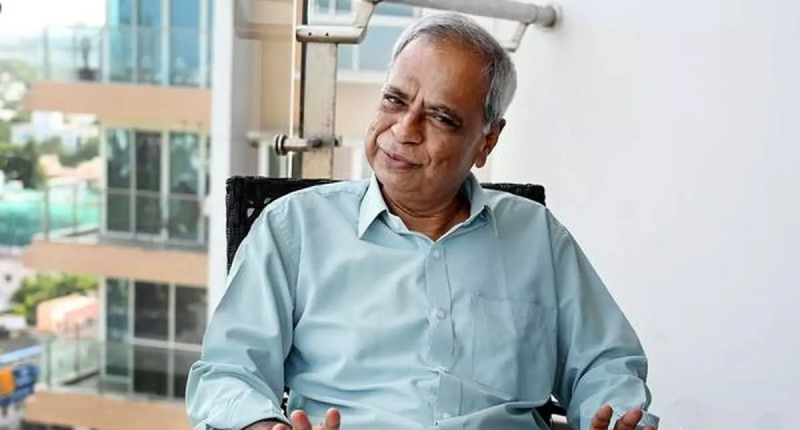Ashok Jhunjhunwala, businessline’s Iconic Changemaker, has had a hand in many of what we use today — from mobile payments and telecom networks to low-cost ATMs and now EVs
One day in 2006, State Bank of India was having one of its offsite board meetings. Each director had to speak for ten minutes about the ‘future of banking’. That was a bit disconcerting for one of the board members — Prof Ashok Jhunjhunwala, a hardcore technologist who taught electrical engineering at IIT Madras. What would he say to expert bankers about the future of banking?
If Jhunjhunwala was nonplussed, it was only momentarily. As he rose to address the board, he decided to approach the issue from his area of expertise. He put one question on the table: How much does it cost the bank if a customer wanted to withdraw, say, Rs. 1,000, if he (a) walked into a bank branch, (b) used an ATM and (c) used his credit or debit card?
The other board members looked at one another and, after a couple of phone calls, got the professor his answer — the costs were Rs. 70, Rs. 12 and Rs. 2, respectively. The professor smiled. “That,” he told the bankers, “is the future of banking.” Give credit or debit cards to all customers, he said. Those were the days when the country was on the cusp of a plastic money boom. Some raised counter questions: Credit cards are inherently risky, and debit cards could be misused.
The midas touch
Prof Jhunjhunwala’s strength lay in telecommunications. Previously, he had invented wireless in local loop and started a company, Midas Technologies, to make landlines low-cost and ubiquitous. Midas Technologies was to later turn out to be the seed of what went on to become one of the finest telecom technology companies in the world, Tejas Networks.
Jhunjhunwala, a telecom wonk, offered the bankers a ready solution to their well-founded risk perceptions of credit and debit cards. He said, “Why can’t we send an SMS to the customer after every transaction?”
That was an interesting proposition but the bankers were still doubtful. How can we send a message as soon as the transaction is done, almost in real time, they wondered. “Leave that to me,” said Jhunjhunwala.
In the days to come, the idea evolved into something that has become an integral and indispensable part of our everyday life — one time password.
Prof Jhunjhunwala — of Rajasthani ancestral origin, Bihari by birth and a Tamilian by domicile (he’s married to a Tamilian) and the recipient of businessline’s Iconic Changemaker award for 2024 — has touched the lives of millions of people in more ways than one.
In fact, the ubiquitous UPI system that India has become known for has its origins in Jhunjhunwala’s brain. It was he who, back in 2007, wondered aloud why ‘mobile-to-mobile’ payment could not be made possible. To give the sprog a jumpstart, a Mobile Payment Forum of India was started in 2007, of which Jhunjhunwala was the chairman for several years.
Jhunjhunwala’s ideas were all way ahead of their times. Attempting something seemingly impossible takes conviction in the idea and in oneself. He attributes his possession of this conviction to a seminal piece of wisdom handed down to him in 1970, when he was a student at IIT Kanpur, by a certain elder from Bihar.
Hanuman Prasad Khaitan, who lived in village Lakhisarai in Bihar, was a Gandhian who had participated in the fight for Independence. After Gandhiji passed away, Khaitan had become an ardent follower of Vinobha Bhave, who started the ‘Bhoodan’ (land donation) movement in 1951.
When Nehru announced in the mid-1950s the setting up of five, well-funded Indian Institutes of Technology, many elders, including Khaitan, were aghast — because the whole idea behind the Independence movement was to create an egalitarian society. IITs, perceived to be elitist, flew in the face of such an idea. Bhave convinced his followers to discuss among themselves and then take a stand. They did, and concluded that Nehru was, after all, right. Every society needed leading lights. But the village elders did not lose sight of the social purpose behind the IITs.
One day in 1970, Khaitan — who, years later, would be the first to inform Jhunjhunwala of his selection for the prestigious Shanti Swarup Bhatnagar award — called his grandson over and told him, “Ashok, I’m very happy that you have got into IIT Kanpur. You are privileged. But remember this — an IIT graduate should never ask any question except ‘what can I do?’ If something had to be done in the interests of society, it just had to be done.” Jhunjhunwala fully internalised the advice.
And the first time the professor asked himself the question ‘what can I do’ was in 1981, soon after his return from the US, where he had just completed his doctorate from the University of Maine and a tenure as Assistant Professor at the Washington State University.
From the spacious balcony of his 13th floor flat that affords a panoramic view of the colourful Adyar-Besant Nagar skyline on one side and the blue sash of the Bay of Bengal on the other, you can see another outstanding creation of Jhunjhunwala, one that is more physical — the IIT Madras Research Park, a house for R&D centres and an incubation centre that has spawned over 300 start-ups.
The luxurious but sparsely furnished flat does not belong to Jhunjhunwala — it is owned by a former student of his, now an industrialist. When the professor retired at 70 last year and needed to move out of the IITM campus, the industrialist insisted that the professor take his flat because “you are like my father”. Digging his heels in, Jhunjhunwala convinced the industrialist to accept rent.
Sense of nostalgia
Thank providence for that because otherwise the professor would have shifted from the idyllic and sylvan setting of the IIT campus into the noise and bustle of the city. The 13th floor flat is enveloped in peace and quiet, providing a meditative ambience appropriate for the septuagenarian who is deeply into walking, yoga and meditation.
Sitting in that breezy balcony for a chat with businessline , the professor, who counts Ray Stata,
co-founder of Analog Devices, and Dr Anil Kakodkar, among his mentors, lets his memories wander over those years, and one could discern a sense of nostalgia as well as pained resignation. The golden light of the setting sun striking the back of his head he reminisced about the early days.
“I was settling down in IIT Madras and had just got married in 1983,” he recalls, adjusting his dhoti to the strong breeze from the Bay of Bengal. As if on cue, Bhavani, his wife, arrives with a tray of tea and snacks. “ Idhar rakh do ,” the professor tells his wife, pointing to a stool — they speak Hindi at home, mostly. Bhavani, a retired official of Indian Overseas Bank, places the tray on the stool and recedes to the background, as the professor resumes his reminiscences.
In the early 1980s, it would cost Rs. 40,000 to have a telephone installed and a typical monthly bill would be Rs. 1,200. Jhunjhunwala wondered what it would take to slash the capital cost to a fourth and the monthly bill to Rs. 250. The professor examined the three major parts of the telecom network — the backbone network, the exchange and the local loop, where a pair of copper wires come from the exchange into every home with a telephone. He realised that the cost of the backbone network would come down with the advent of optic fibre. As for the exchange, Sam Pitroda had just set up
C-DOT with modern switching technology and the costs were falling. But the cost of the local loop was going up because the cost of copper and the cost of installation were both rising. The answer was to
go wireless for the local loop. Many IIT alumni and two colleagues — Prof Bhaskar Ramamurthi and Prof Timothy Gonsalves (who later became Directors of IIT Madras and Mandi, respectively) — joined hands with Jhunjhunwala. Midas Technologies was born.
In the normal course of things, Midas would have become a telecom giant, but it only created enemies in high places who did everything to crush it, like snatching away the spectrum allotted to it — though it is another matter that the core team of Midas, at Jhunjhunwala’s instance, formed Tejas Networks, which is today one of world’s six telecom companies capable of producing 5G gear. Midas did not take off despite having support from people like Prof PV Indiresan (former IIT M director, who spoke vociferously and emotionally at a pre-budget meeting called by then finance minister Yashwant Sinha, and then fainted), MGK Menon, Prof Yashpal, and former Central Vigilance Commissioner N Vittal. “Those were the worst years of my life,” says Jhunjhunwala. Indiresan collapsing at the meeting created quite a stir, bringing the Midas issue to the attention of LK Advani. But none of these men in
high places could save the company.
Midas did set up WLL systems in several towns and villages — this writer remembers visiting one of them in 2004 — but was done in by the system. “Five years of inactivity was too much of a blow for Midas,” he says. A happy coda to the story was the professor getting the Padma Shri award for his WLL work.
Even as he was wrestling for Midas, Jhunjhunwala was working on another dream — to set up a research and incubation centre. Conceived in 2008 and built two years later, with zestful support of the then Director, MS Ananth and others, the IIT Madras Research Park and its subsidiary, IIT Madras Incubation Cell, popped up to become the best recognised landmark on Chennai’s famous ‘IT corridor’. The IIT M Research Park is a unique model, built out of alumni donations and bank borrowings and (deliberately) zero financial support from IIT Madras. The corporate R&D centres that rent space at the park and the start-ups incubated there are mentored by IIT professors. The
Research Park is a Section 8 (not for profit) company but it makes a handsome surplus from its rental income, which is ploughed back into expansion. And the 300-plus start-ups that were born there today boast of a cumulative turnover of Rs. 40,000 crore ($5 billion). But Jhunjhunwala is, well, not fully satisfied. He wants to raise the number of incubatees to 1,000 by 2030 — from about 45 a year today.
Illustrious career
Midas, mobile banking and IITM Research Park are but a few highlights of Prof Ashok Jhunjhunwala’s illustrious career — but neither is the list exhaustive nor is the man exhausted. He has had a hand in many, many things that we have come to take for granted today. For example, his efforts led to low-cost ATM machines, bringing down the cost from Rs. 10 lakh to Rs. 75,000 — without which it is difficult to see ATMs commonplace. He has tomes of work to his credit in DC-powered household electrical appliances that can take feed directly from a rooftop solar plant. Today, he is neck-deep in electric vehicles and their components, such as batteries and motors. The professor is busy starting a
new company, which could be something big, but “wait for details”. As the crimson sun sets behind the imposing towers of the IIT M Research Park, you can bet your last buck that when it rises again in the Bay, Prof Jhunjhunwala will come up with something new.
Publication: The Hindu Bussinessline
Read more at: https://www.thehindubusinessline.com/blchangemakers/a-man-of-many-innovations/article68670336.ece
![]()


